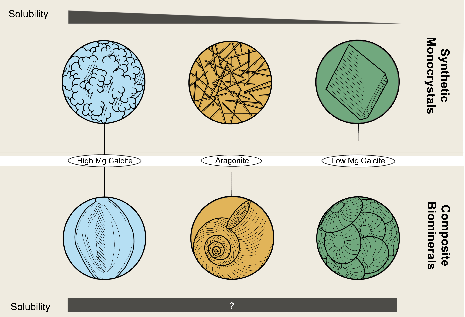The vulnerability of marine shells to ocean acidification does not depend solely on their mineral composition
The resistance or vulnerability of marine organisms’ shells to ocean acidification does not depend only on the type of mineral they are made of, as previously thought, but also on factors such as their microstructure and organic content. This is the main conclusion of a study by the ICTA-UAB, which calls for a reassessment of current scientific models.

Ocean acidification — driven by increasing atmospheric CO₂ — has become a critical threat to marine life, particularly for organisms that build calcium carbonate shells. For years, it has been widely assumed that organisms with aragonitic shells (a more soluble form of Calcium carbonate CaCO₃) are more vulnerable than those with shells made of calcite (a less soluble form). However, this assumption was based on the behaviour of synthetic monocrystals produced in inorganic precipitation experiments. Calcium carbonate shells, by contrast, are highly complex structures containing organic material as well as minerals. A new study reveals a far more complex reality challenging oversimplified assumptions based synthetic monocrystals
The research shows that the vulnerability of these organisms cannot be predicted based solely on the mineralogy of their shells. Instead, other factors — such as the shell’s microstructure and organic content — are also critical for understanding how these structures respond to undersaturated and corrosive conditions.
“We have a generalized idea about the impact of ocean acidification on marine shells, but it's not enough to know whether they're made of aragonite or calcite. It also matters how they're built,” explains Gerald Langer, ICTA-UAB researcher and lead author of the study. The way organisms build their shells — including internal structure and organic matter — varies between species and can significantly influence their resistance to more acidic seawater.
The experimental evidence analyzed by the team includes cases where structures made of the same mineral exhibit very different dissolution behaviours, depending on their internal design or the presence of organic coatings. A paradigmatic example is that of coccolithophores, where the same species shows variable shell resistance depending on its life cycle stage, even though all phases use the same type of calcium carbonate.
This finding has important implications for conservation policies and for scientific models predicting the impacts of climate change on marine biodiversity. Many of these models use mineralogy as a direct proxy for vulnerability — a practice that, according to this new research, needs to be fundamentally re-evaluated.
“This study challenges one of the foundations of relevant scientific assessments used by international bodies, by showing that mineralogy alone does not predict the resilience of calcifying species in acidifying oceans,” says Patrizia Ziveri, ICTA-UAB research professor and co-author of the study. ““As oceans continue acidifying, improving our understanding of which species are most at risk is essential for designing effective protection strategies,” Ziveri adds.